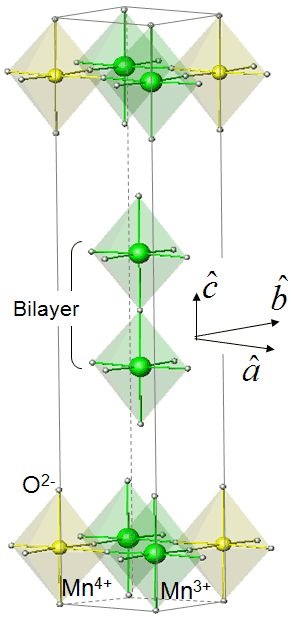A Material's Magnetic Surprise Could Mean New Technologies
August 28, 2011
By Laura Mgrdichian

The layered structure of the bilayer manganite.
Scientists working at the National Synchrotron Light Source have discovered an unusually fragile, unstable magnetic state in a member of a class of materials known for its robust magnetic behaviors. Their discovery could lead to applications in the emerging field of spintronics – electronics based not on electric charge but on electron spin, a property that is very closely linked to magnetism.
The research was published on July 15, 2011, in the online edition of Physical Review Letters. It was performed by researchers from NSLS, the Stanford Synchrotron Radiation Lightsource at SLAC National Accelerator Laboratory, Pohang University of Science and Technology (Korea), Rutgers University, and the University of Illinois.
The material under study is a compound of the elements manganese (Mn), lanthanum (La), and strontium (Sr), and belongs to a family of materials called bilayer manganites. These materials may be best known for exhibiting “colossal magnetoresistance,” a drastic change in electrical resistance in response to a magnetic field. Structurally, they consist of a repeating layered pattern: a double layer of manganite (MnO2) sandwiched between two single layers of a non-magnetic mixture of La and Sr atoms.
The La and Sr atoms are added in small (and variable) amounts to change the material's electronic and magnetic properties, a practice called doping. Here, the group was interested in the “half-doped” version: for each MnO2 layer, there was one La atom and two Sr atoms. In this case, the Mn atoms in the MnO2 layer become a mix of two positive ions, denoted Mn3+ and Mn4+ (one carries three extra units of positive charge, the other four), ordered in a checkerboard pattern.
By aiming a beam of x-rays at the sample and analyzing how the light reflected, the group investigated the Mn-ion checkerboard to gather information about the orbitals and spins of the electrons within it (an orbital is the region around an atomic nucleus where an electron is likely to be located; spin is an electron's built-in angular momentum).
The analysis revealed two types of antiferromagnetic patterns, which arise in response to the electron spins. The patterns, known as “A-type” and “CE-type,” are closely coupled. Surprisingly, they can exist at the same time or individually, although the CE-type can easily destabilize into the A-type, even when the doping levels are changed only slightly. These behaviors are very unlike the strong, steady magnetic response that is typical of manganites.
"We clearly demonstrate that the interplay among charge, orbitals, spin, and lattice degrees of freedom leads to exotic phenomena in these materials,” said SLAC researcher Jun-Sik Lee, who led the study. “Moreover, this finding demonstrates the rich variety of spin couplings in these materials, which may be useful in engineering spintronic devices for our future."
This research was performed in part at NSLS beamline X1B.
PUBLICATION: J.-S. Lee, C.-C. Kao, C. S. Nelson, H. Jang, K.-T. Ko, S. B. Kim, Y. J. Choi, S.-W. Cheong, S. Smadici, P. Abbamonte, and J.-H. Park “Fragile Magnetic Ground State in Half-Doped LaSr2Mn2O7” Physical Review Letters 107, 037206 (2011).
SLAC National Accelerator Laboratory highlight
2011-2539 | INT/EXT | Newsroom









